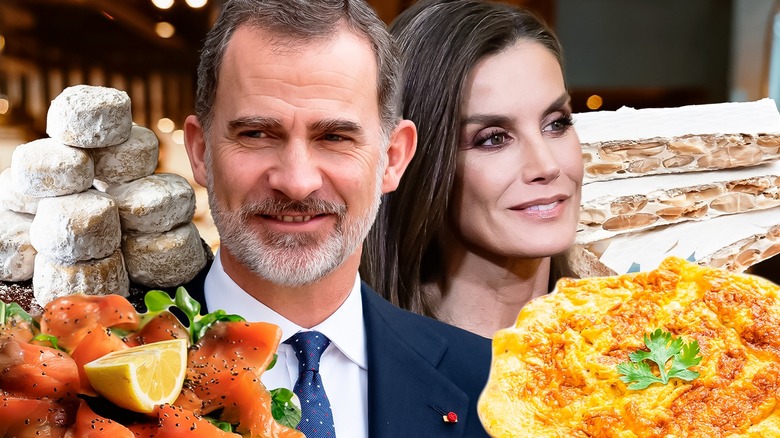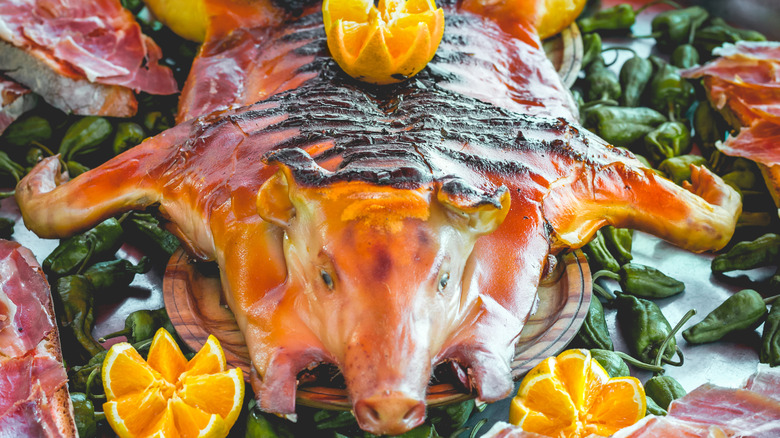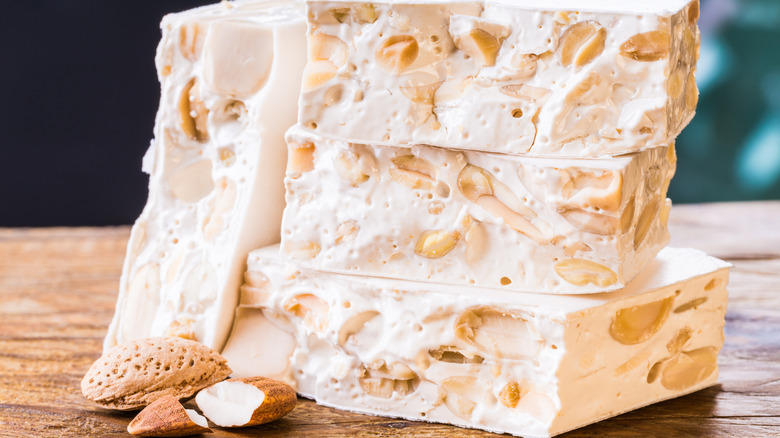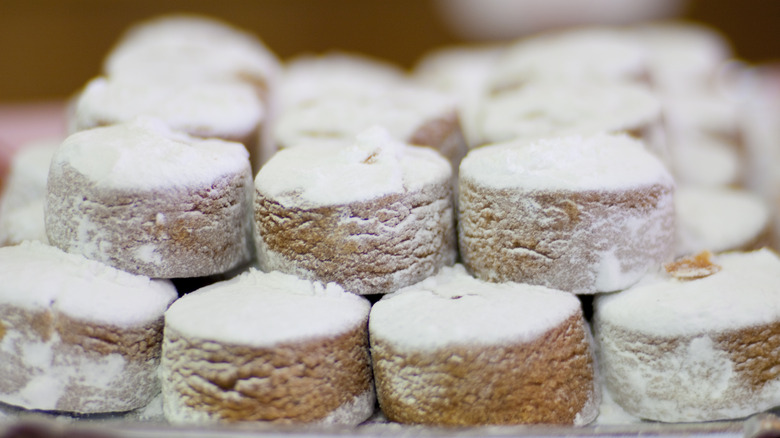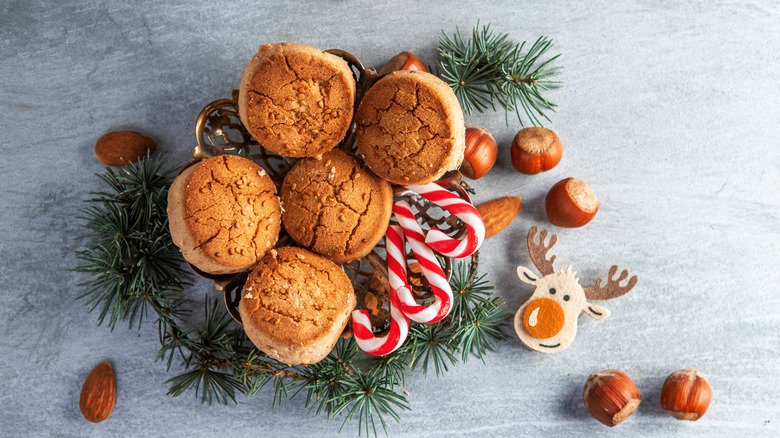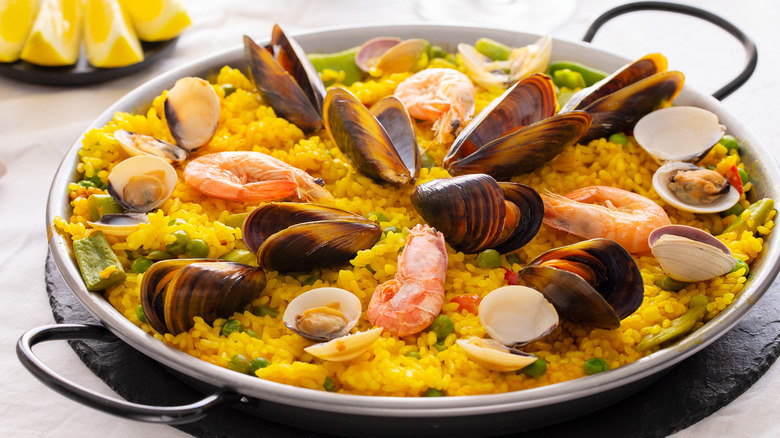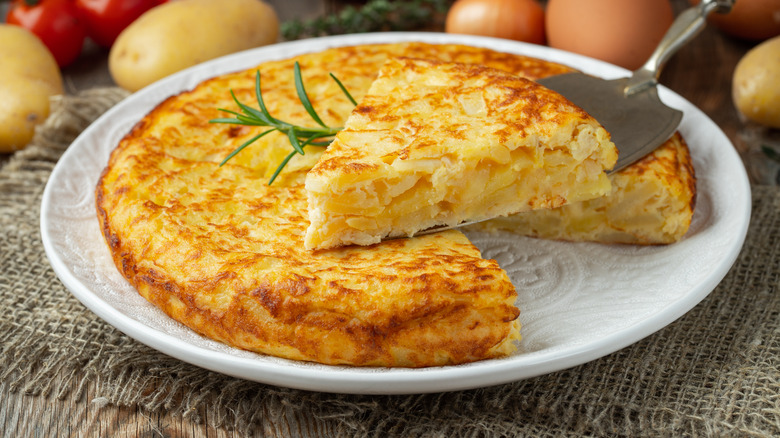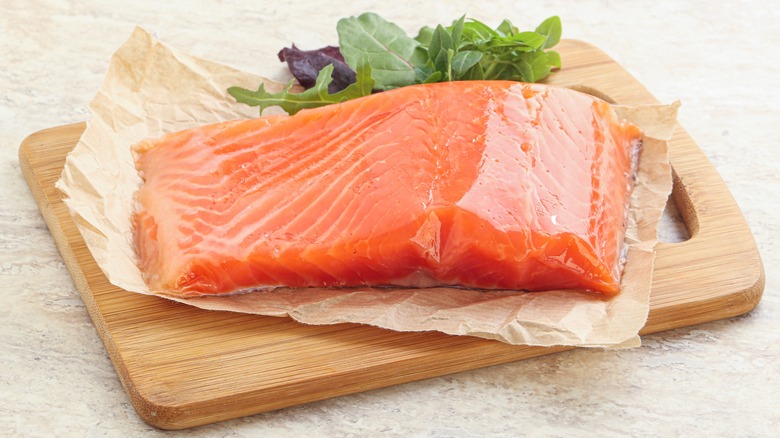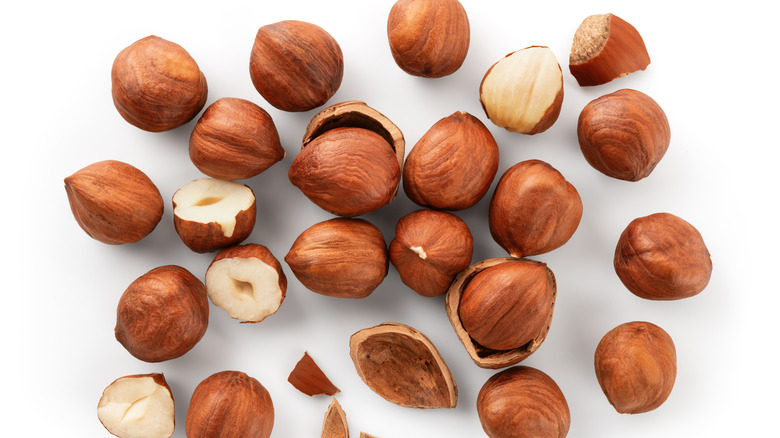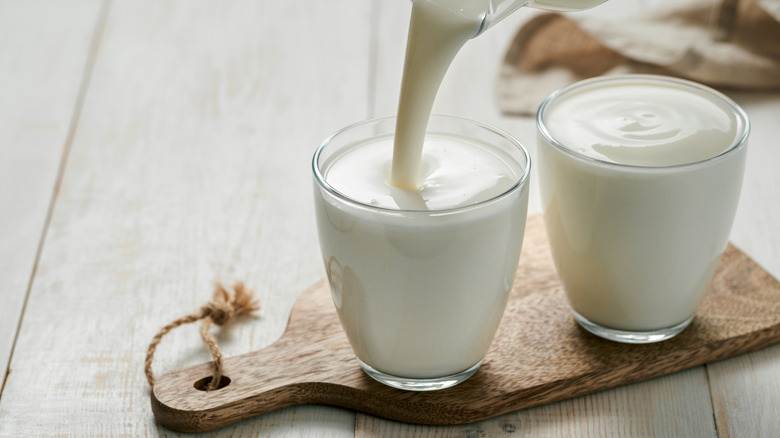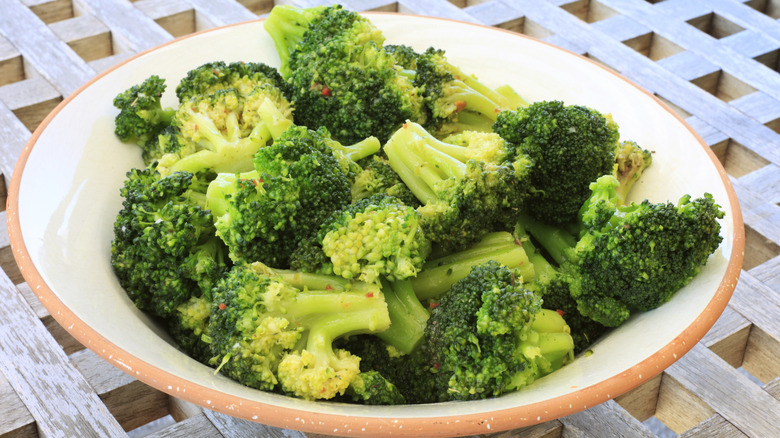What The Spanish Royal Family Really Eats
While none of us regular folks can truly know what it's like to be a member of European nobility, we can try to put ourselves in their shoes by learning what they eat. We might imagine that royals would always eat luxuriously, but the diet of the British royal family, for example, is limited by restrictive rules — it's not all caviar, all the time. Whether you prefer to "eat like a king," or your food ethos is more "food is medicine," you might find that you have something in common with the Spanish royal family. King Felipe of Spain reportedly enjoyed his fair share of steaks and burgers until he changed his diet to shed a few pounds in 2015. Queen Letizia has tended more toward the physician-designed Perricone diet.
While the royals' eating habits seem to remain rather consistent throughout the year, like many families across the globe, Christmas is also a time of treats, indulgence, and ditching diets in favor of traditional foods and delicacies that may not be enjoyed at other times. The Spanish royal family is known for enjoying the same foods during the holiday season as other Spanish families.
If you've ever wondered what the Spanish royal family eats, read on to find out. From healthy steamed broccoli, omelets, and kefir to indulgent nougats and soft crumbly cookies, the options are as diverse as one would hope. Better yet, some of the selections even reveal important aspects of Spanish food history and culture.
Entremeses
The royal family eats the same Christmas foods as the rest of Spain. As is customary, entremeses get things started. Often served as an appetizer before Christmas Eve and Christmas Day meals, entremeses are essentially a selection of cured meats and cheeses — like a charcuterie board. Popular Spanish cured meats are used in addition to local cheeses like Manchego, Cabrales, Mahón, and torta del Casar. Among the cured meats are a range of hams that could include jamón Ibérico de Bellota (an Iberian ham made from acorn-fed Iberian pork), jamón Ibérico, which is made from free-range black Iberian pork, and jamón Serrano — a bright pink/purplish ham that is made using methods that date as far back as ancient Rome. King Felipe reportedly counts Ibérico ham among his favorite foods. If you want to eat like the King of Spain, it'll cost you — Ibérico ham is incredibly expensive.
For the Spanish royals, Christmas is a two-day affair featuring a series of traditional rituals and some typical Spanish dishes. The main festivities commence on Christmas Eve when the King addresses the nation before the family has dinner and then attends Midnight Mass. While Christmas Day features presents for the children, an elaborate, multi-course lunch featuring roasted meats is the centerpiece of the December 25th celebration.
Cochinillo
Otherwise known as roast suckling pig, cochinillo is another delicacy that will be found on the Spanish royal family's Christmas banquet table. A central part of traditional Spanish cuisine, cochinillo is often eaten on special occasions. Cochinillo is a whole roasted piglet that is cooked using a two-step process. First, it is butterflied and seasoned with salt, thyme, garlic, and olive oil before it is roasted for about an hour in a clay dish. Once it has been roasted and cooled, it is roasted again in order to get the skin brown. Cochinillo has been a coveted Spanish delicacy for centuries and has since spread to other countries including Cuba, the Philippines, Puerto Rico, and Mexico.
Additionally, it has been referenced in notable pieces of literature like "The Sun Also Rises" by Ernest Hemingway and "Don Quixote" by Cervantes — which dates back about 400 years. The preparation of this delicacy does not begin with the roast alone — rather, it begins as soon as the piglets are born. The piglets are fed only the milk of their mothers and given no vitamins or hormones before being slaughtered when they are four to five weeks old. By the age at which they are slaughtered, the piglets have not yet reached ten pounds in weight. The resulting meat is shockingly juicy and tender, providing an amazing contrast to the crackling-crisp skin.
Turrón
Another Christmas delicacy that the Spanish royals enjoy is turrón. Also known as Spanish nougat, turrón is a confectionery with a rich history. The word itself is reported to have been derived from the word torrar in Catalan and the Latin words "torrere" (which translates to "roasting") and "terra" (taken from "terró" which translates to "cloud of earth"). Turrón has been a popular sweet for centuries. It is reported to have Arabic origins. Invented by the Moors more than 500 years ago, this sweet traditional delicacy was first made in Jijona — a little town situated north of Alicante. There are two types of turrón with names that serve as a nod to their origins: turrón de Jijona and turrón de Alicante.
Turrón de Jijona is a soft nougat that is made using egg whites, honey, roasted almonds, and sugar, while turrón de Alicante refers to a hard nougat that is made using similar ingredients. There are several other popular versions of turrón in Spain. Among these are turrón de Agramunt and turrón de Cherta, which both may incorporate hazelnuts. Turrón de trufa and turrón de chocolate are made of various types of chocolate, while turrón de coco includes dried coconut. Turrón de yema tostada is a Catalan variety that incorporates egg yolks.
Polvorones
Polvorones, or pan de polvo — which means "powder bread" or "dust bread" — are another traditional Spanish delicacy that was formerly reserved for the Christmas season. Now enjoyed all year, polvorones are shortbread cookies that are made using flour, milk, nuts, and sugar. Like other types of shortbread, polvorones have a soft, crumbly texture. They are often topped with powdered sugar. Like turrón, polvorones are another treat that the Spanish royals eat during the holiday season. These cookies have also spread to other countries like Cuba, the Philippines, Puerto Rico, and Mexico.
These shortbread cookies reportedly originated in Andalucia during the 16th century. Their invention seems to have been encouraged by the pig farming industry; the region had become known for cultivating good quality pork products. Andalucia's forests contained large numbers of oak trees that produced acorns that pigs could feed on. This led to locals using lard in their cooking, which in turn, led to its use in these cookies too. Today, polvorones go by different names depending on location. For instance, in Puerto Rico, they are called mantecaditos or polvorones Puertorriqueños and are usually topped with sprinkles or guava paste rather than powdered sugar. In South Texas, they are called Mexican wedding cookies — even though they are not typically served at weddings in Mexico.
Mantecados
Like polvorones, mantecados are traditional Christmas cookies. Unlike their cookie cousins, they are still largely relegated to the holiday season. They also form part of the Christmas celebration for the Spanish royal family. The word "mantecados" is derived from the Spanish "mante," which translates to "lard." Like polvorones, they too are from Andalucia and boast a soft, crumbly texture. Estepa and Antequera are the two towns in the region that have laid claim to being the original creators of mantecados. These claims have led to a mantecado rivalry between the two towns. The origin story of the cookies is that either Estepa or Antequera came up with the recipe as a way of using an excess of flour and lard.
The cookies eventually became popular in other regions when settlers took them to their colonies. Today, Estepa reportedly manufactures 20 million kilograms (a little over 44 million pounds) of mantecados per year, which makes up about 40% of the total annual mantecado production across Spain. A typical mantecado recipe includes 50% flour and 25% each of lard and sugar. Other ingredients that may be added include cinnamon, coconut, and lemon.
Seafood (paella de mariscos)
Seafood is a big part of Spanish cuisine and often serves as the anchor of the Spanish Royals' holiday meals. King Felipe is a big seafood fan; his favorite fish is sole. Paella is a very popular way to consume seafood in Spain. Paella is a rice dish that can be made using an array of ingredients from meat or seafood to vegetables or a combination of everything. Paella de mariscos is the seafood version of the dish. Like all paella, it is meant to incorporate whatever you have on hand, allowing you to use the freshest seafood you have access to on the particular day you wish to make it. This is in line with the history of the dish, as farmers and laborers would prepare rice mixed with whatever ingredients they had on the land in a big pan on a fire.
Interestingly, while paella is considered to be Spain's national dish in other parts of the world, Spanish people class it as a Valencian dish, despite its availability in every region across Spain. As such, paella Valenciana is considered to be the most authentic form of paella. In addition to the essential ingredients like short or medium-grain rice, sofrito, and stock, paella Valenciana contains chicken and rabbit. Other types include paella de verduras, which includes beans and vegetables, and paella negra, which is a black variant that is prepared in squid ink and features a range of seafood like crab and cuttlefish.
Omelet
It is hard to say where the concept of the omelet originated, as it has as many variants across the world. It seems like the word "omelet" was first published in a French cookbook called "Cuisine Bourgeoisie" during the 17th century. However, omelets are hardly exclusive to the French. For Spain's Queen Letizia, an egg-white omelet is a part of her Perricone diet. This diet, which was developed not by a dietician or a nutritionist but instead by a dermatologist named Nicholas Perricone, is alleged to reduce inflammation, promote healthy skin, and slow the aging process (via Perricone MD).
In Spain, the variation of the omelet that is traditionally consumed is the Spanish tortilla or tortilla Española. Now part of a typical breakfast in Spain, it is believed to have been created during the First Carlist War between 1833 and 1839. According to the Spanish legend, a General of the Spanish army had stopped by a local Navarre home. The poor housewife he found there gathered eggs, onion, and potatoes and cooked an impromptu meal, inadvertently creating what would come to be known as the Spanish tortilla. Another story says that it was General Tomas Zumalacarregui who created the dish as a fast and easy way to feed an army. Today, you can find it made with the same ingredients the Navarre housewife used or with additional ingredients like chorizo or fried peppers.
Salmon
Queen Letizia may have a simple piece of salmon with her breakfast as part of the health-focused Perricone diet she follows. Salmon and other cold-water fish like trout make up the backbone of the diet and can be eaten at all meals. While Letizia probably eats her salmon relatively plain, if you want a more flavorful option, try a traditional salmon dish from Spain like salmon a la Gallega.
Originally from Galicia in Northwestern Spain, salmon a la Gallega is made using garlic, olive oil, and paprika. The fish is seared and served with sliced boiled potatoes in a paprika-spiked sauce flavored with wine and garlic. This dish should be made with waxy potatoes as they hold their shape and don't fall apart when boiled. For those who are not fond of white wine or who avoid alcohol, the wine can be replaced with a stock or a broth. This dish is also commonly made with octopus. Salmon a la Gallega is a healthy alternative to traditional Spanish fried fish, which consists of boneless white fish filets fried in a crispy breading.
Nuts
Hailed as trendsetters within the nut industry, Spain's nut sector has been praised as one that expertly combines tradition with innovation. Among the nuts produced in Spain, almonds, chestnuts, and hazelnuts make up the bulk of production. In 2017 alone, 800,000 hectares of land were allocated to the cultivation of these nuts, the majority of which went toward the cultivation of almonds. As already noted, both almonds and hazelnuts are prominent ingredients in Spanish nougat. Queen Letizia enjoys hazelnuts as Periccone Diet-approved snacks.
Three popular Spanish nut varieties are Marcona almonds, almendra de Mallorca, and avellana de Reus. Marcona almonds are a highly-coveted variant that is similar to macadamia nuts in texture. They taste sweeter and more buttery than standard almond varieties and can be incorporated into a wide range of recipes. Almendra de Mallorca is an almond variant with a name that speaks to its origins. It is cultivated in Mallorca, a status that is protected by law. They have a strong flavor and high fat content. Finally, avellana de Reus are hazelnuts that have been cultivated in the Tarragona province. Like Mallorca almonds, their geographical provenance is legally protected.
Kefir
Although kefir is not a big part of Spanish history and cuisine, it does feature quite prominently as a part of Queen Letizia's Perricone diet. Among the foods that are consumed on a daily basis as part of the diet are fish, eggs, vegetables, and natural yogurt. This is where kefir comes in. With a history that stretches as far back as 4,000 years, kefir is milk that Karachai nomads in the Caucasus mountains would mix kefir grains into before leaving to ferment in leather skins. Kefir grains are small lumps of microorganisms that ferment fresh milk into kefir. These grains were once so highly regarded that they would be passed down as heirlooms from one family generation to the next.
Because the Karachai people believed that the grains came directly from Prophet Muhammad, the fermentation process was viewed not so much a scientific process as it was a divine one. The grains turned milk into a healthier drink that was safe and fortified the bodies of those who drank it. So divine was this process that kefir grains were a secret that the Karachai people fiercely protected. This remained so until researchers from Russia started to research the reasons behind the people of the Caucasus mountains' long lives and vitality during the 14th century. Today, kefir may not be perceived as divine, but it is lauded for its impressive nutrient profile. It's full of probiotics that are good for digestive health.
Steamed broccoli
Spain is the largest producer of broccoli in the world. Given this fact and that it is an ingredient that is featured in the Perricone diet, it is not surprising that steamed broccoli would be a part of Queen Letizia's eating routine. About half of all the broccoli that is cultivated in Spain comes from the Murcia region. More specifically, the Guadalentin Valley has played the most pivotal role in Spanish broccoli production. However, broccoli is not originally a Spanish vegetable — it was first bred by the Etruscan civilization in ancient Italy.
Served as an appetizer or side dish, Spanish Garlic Broccoli is one way to enjoy this vegetable if you cannot stand the idea of plain old steamed broccoli. It's made using garlic, lemon wedges, olive oil, and vegetable broth. Brócoli al ajoarriero is another simple dish in which cooked broccoli is topped with a warm garlic and paprika dressing. Ultimately, while Spanish cuisine did not historically feature broccoli, its recent popularity has led to its incorporation into Spanish dishes.
